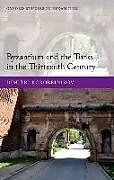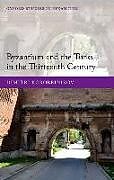Byzantium and the Turks in the Thirteenth Century
Einband:
Fester Einband
EAN:
9780198708261
Untertitel:
Englisch
Genre:
Geschichte
Autor:
Dimitri Korobeinikov
Herausgeber:
Oxford Academic
Anzahl Seiten:
396
Erscheinungsdatum:
25.09.2014
ISBN:
978-0-19-870826-1
Zusatztext Byzantium and the Turks in the Thirteenth Century is a major new contribution to a question of great historical importance. As the most thorough and in-depth discussion of the triangle of Byzantine-Seljuk-Mongol relations in the thirteenth century, it is indispensable reading for any historian interested in the collapse of Byzantium and the emergence of Turkish power. Informationen zum Autor Dimitri Korobeinikov is Assistant Professor at the University at Albany SUNY, and a Senior Research Fellow in the Centre for Byzantine Studies, Institute of World History, Russian Academy of Sciences. He was Senior Research Fellow in the Research Center for Anatolian Civilizations, University of Koç, Istanbul, in 2013; Fellow in Dumbarton Oaks, 2006-2007; and Junior Research Fellow in Wolfson College (Oxford). Klappentext Using Greek, Arabic, Persian, and Ottoman sources, this volume looks at the relations between Byzantium and its eastern neighbours in the thirteenth century, and presents a new interpretation of the Nicaean Empire and highlights the evidence for its wealth and power. Zusammenfassung Using Greek, Arabic, Persian, and Ottoman sources, this volume looks at the relations between Byzantium and its eastern neighbours in the thirteenth century, and presents a new interpretation of the Nicaean Empire and highlights the evidence for its wealth and power.
Autorentext
Dimitri Korobeinikov is Assistant Professor at the University at Albany SUNY, and a Senior Research Fellow in the Centre for Byzantine Studies, Institute of World History, Russian Academy of Sciences. He was Senior Research Fellow in the Research Center for Anatolian Civilizations, University of Koç, Istanbul, in 2013; Fellow in Dumbarton Oaks, 2006-2007; and Junior Research Fellow in Wolfson College (Oxford).
Klappentext
Using Greek, Arabic, Persian, and Ottoman sources, this volume looks at the relations between Byzantium and its eastern neighbours in the thirteenth century, and presents a new interpretation of the Nicaean Empire and highlights the evidence for its wealth and power.
Inhalt
List of Illustrations
List of Abbreviations
Note on Transliterations
Map (Asia Minor c. 1265)
Genealogical Table
Introduction: The Thirteenth Century
1: The Sources
2: The Nicaean Paradox
3: The Sultanate of Rum: Preliminary Remarks
4: Nicaean-Seljuk Relations
5: The Mongols
6: The Age of Revolts: The Loss of Byzantine Asia Minor
7: The Aftermath: Asia Mino after 1303
Conclusion: Byzantium in the Thirteenth Century: Diplomatic Success and Military Failure
Bibliography
Index

Leider konnten wir für diesen Artikel keine Preise ermitteln ...
billigbuch.ch sucht jetzt für Sie die besten Angebote ...
Die aktuellen Verkaufspreise von 6 Onlineshops werden in Realtime abgefragt.
Sie können das gewünschte Produkt anschliessend direkt beim Anbieter Ihrer Wahl bestellen.
Loading...
Die aktuellen Verkaufspreise von 6 Onlineshops werden in Realtime abgefragt.
Sie können das gewünschte Produkt anschliessend direkt beim Anbieter Ihrer Wahl bestellen.
| # | Onlineshop | Preis CHF | Versand CHF | Total CHF | ||
|---|---|---|---|---|---|---|
| 1 | Seller | 0.00 | 0.00 | 0.00 |
